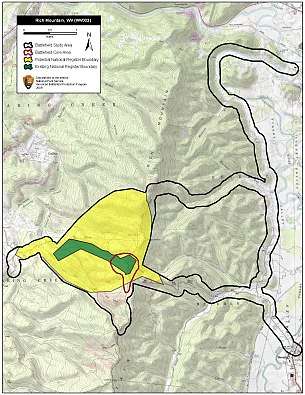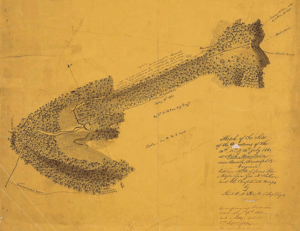Battle of Rich Mountain
The Battle of Rich Mountain took place on July 11, 1861, in Randolph County, Virginia (now West Virginia) as part of the Operations in Western Virginia Campaign during the American Civil War.[1][2]
Background
Maj. Gen. George B. McClellan assumed command of Union forces in western Virginia in June 1861. On June 27, he moved his divisions from Clarksburg south against Lt. Col. John Pegram's Confederates, reaching the vicinity of Rich Mountain on July 9. Meanwhile, Brig. Gen. Thomas A. Morris's Union brigade marched from Philippi to confront Brig. Gen. Robert S. Garnett's command at Laurel Hill. On July 10–11, Brig. Gen. William Rosecrans led a reinforced brigade by a mountain path to seize the Staunton-Parkersburg Turnpike in Pegram's rear.[1]
Opposing forces
Union
Confederate
Battle

A sharp two-hour fight ensued in which the Confederates were split in two. Half escaped to Beverly and on over the Shawnee Trail, but Pegram and the others (including the "Sydney Boys", a regiment formed from the students of Hampden-Sydney College) surrendered on July 13.
Aftermath
Hearing of Pegram's defeat, Garnett abandoned Laurel Hill. The Federals pursued, and, during fighting at Corrick's Ford on July 13, Garnett was killed; he was the first general officer to be killed in the war.[3] On July 22, McClellan was ordered to Washington, and Rosecrans assumed command of Union forces in western Virginia. The Union victory at Rich Mountain was instrumental in propelling McClellan to command of the Army of the Potomac.[1]
Preservation
The battlefield and Camp Garnett today are owned and protected by the Rich Mountain Battlefield Foundation.[4] The Civil War Trust (a division of the American Battlefield Trust) and its partners, including the foundation, have acquired and preserved 57 acres (0.23 km2) of the battlefield.[5]
Gallery
 Camp Garnett
Camp Garnett Marker on site of Hart House
Marker on site of Hart House Historical Marker on Rich Mountain
Historical Marker on Rich Mountain Looking at summit of Rich Mountain
Looking at summit of Rich Mountain Looking westward (downhill) from Rich Mountain summit
Looking westward (downhill) from Rich Mountain summit
Notes
- "Battle Summary". National Park Service. Retrieved 11 July 2016.
- "Concise History of the Battle of Rich Mountain". Rich Mountain Battlefield Foundation. Retrieved 11 July 2016.
- Kennedy, p. 8.
- Rich Mountain Battlefield Foundation. Accessed May 25, 2018.
- American Battlefield Trust "Saved Land" webpage. Accessed May 25, 2018.
References
- Kennedy, Frances H., ed. The Civil War Battlefield Guide. 2nd ed. Boston: Houghton Mifflin Co., 1998. ISBN 0-395-74012-6.
- Taylor, Paul. Orlando M. Poe: Civil War General and Great Lakes Engineer. Kent, OH: Kent State University Press, 2009. ISBN 978-1-60635-040-9.
- Zinn, Jack. The Battle of Rich Mountain. Parsons, WV: McClain Printing Company, 1971. ISBN 0-87012-094-8.
- CWSAC Report Update and Resurvey: Individual Battlefield Profiles
External links
- National Park Service Battle Summary
- Rich Mountain Battlefield Foundation
- Rich Mountain Revisited Dallas B. Shaffer, October 1966
